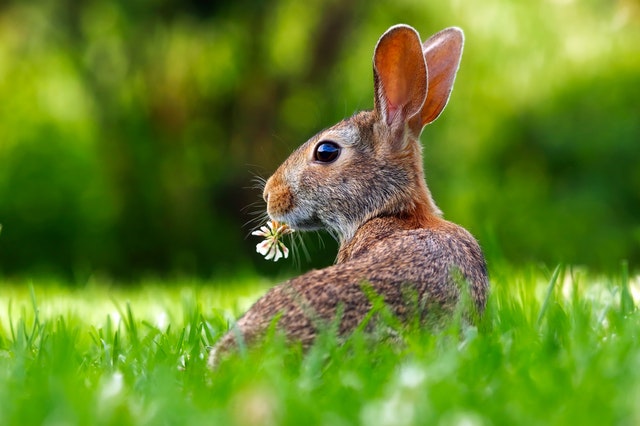Rabbits prefer a diet of hay, grass, and greens, but will eat almost anything if given the chance.
For example, wild rabbits may eat anything from flowers and fruit to twigs and seeds, and even the bark of different trees.
When it comes to houseplants, domestic rabbits may favour your laptop power cord or another such item.
Yes, in general, rabbits can eat flowers (and they do so with great enthusiasm), namely the petals; no, however, because some flowers are not suitable for consumption due to being poisonous or otherwise harmful to the rabbit’s digestive system.
As we said before, wild rabbits will supplement their diet with flowers if they are accessible, but this will depend on the territory they are in and the food sources available there.
The farmed rabbit may not be able to tell the difference between healthy and poisonous meals, despite the fact that wild rabbits can.
Some of them have lost the ability to distinguish between good and poor foods, in part because their diets lack the variety they would find in the wild.
Our pet rabbits may chew on cords, furniture, or the numerous flowers we may have in our homes and gardens because they need to gnaw on objects to keep their teeth at optimal length, as rabbits’ teeth grow continuously.
Therefore, as long as they are edible, rabbits will eat flowers.
In contrast to their wild counterparts, house rabbits may not be aware of which flower petals are safe to touch and which ones are poisonous.
What Flowers Can Rabbits Eat
In general, any flower or petal that is edible to humans is safe for your pet rabbit. However, we will do our best to compile a list of the most commonly encountered flowers that are safe for rabbit consumption.
Here, then, are a few examples of the most typical rabbit food plants:
Annual Flowers
Many annual bedding plants are favored by rabbits, including:
- Bachelor’s Button (Centaurea cyanus)
- Cockscomb (Celosia argenta cristata)
- Cosmos (Cosmos bipinnatus)
- Gazania (Gazania rigens)
- Impatiens (Impatiens walleriana)
- Morning glory (Ipomoea purpurea)
- Nasturtium (Tropaeolum)
- Pansy (Viola x wittrockiana)
- Petunia (Petunia x hybrida)
- Rose moss (Portulaca grandiflora)
- Snapdragon (Antirrhinum majus)
- Sunflower (Helianthus annuus)
- Sweet pea (Lathyrus latifolius)
- Verbena (Verbena x hybrida)
- Wishbone flower (Torenia)
- Zinnas (Zinnia elegans)
Perennial Bulbs and Flowers
These perennial plants, in particular, are attractive to rabbits:
- Aster (Aster novae-angliae)
- Baby’s breath (Gypsophila paniculata)
- Balloon flower (Platycodon grandiflorus)
- Bellflower (Campanula spp.)
- Black-eyed Susan (Rudbeckia hirta & Goldsturm)
- Clematis (Clematis spp.)
- Coneflower (Echinacea purpurea)
- Coral bells-flowers only (Heuchera sanguinea)
- Crocus (Crocus hybrids)
- Daylillies (Hemerocallis spp.)
- Gayfeather (Liatris spicata)
- Great masterwort (Astrantia major)
- Hosta, Plantain lily (Hosta species)
- Iris (Iris hybrids)
- Iceland poppy (Papaver nudicaule)
- Japanese anemone (Anemone x hybrida)
- Johnny-Jump-Up (Viola tricolor)
- Lilies, oriental and asiatic (Lilium spp.)
- Lupine (Lupinus & Russell Hybrid)
- Maidenhair fern (Adiantum pedatum)
Marguerite daisy (Felicia amelloides) - Marsh blue violet (Viola cucullata)
- Daisy (Aster novi belgii)
- Mountain blue (Centaurea montana)
- Oriental poppy (Papaver orientale)
- Phlox, tall (Phlox paniculata)
- Phlox, creeping (Phlox subulata)
- Pincushion flower (Scabiosa caucasica)
- Pink coreopsism (Coreopsis rosea)
- Sweet woodruff (Galium odoratum)
- Threadleaf coreopsis(Coreopsis verticillata)
- Tree peony (Paeonia suffruticosa)
- Tulip (Tulipa hybrids)
- Vervain (Verbena rigida)
Shrubs
A great many shrubs are at great danger from rabbits eating the tender spring shoots. Severe feeding may even kill the plants.
Some shrubs to avoid if rabbits are a problem include:
- Barberry (Berberis & Crimson Pygmie)
- Common flowering quince (Chaenomeles speciosa)
- Deutzia (Deutzia spp.)
- Doublefile viburnum (Viburnum plicatum)
- Eastern redbud (Cercis canadensis)
- Flowering crabapple (Malus spp.)
- Forsythia (Forsythia spp.)
- Fothergilla (Fothergilla spp.)
- Hawthorn (Crataegus spp)
- Japanese flowering quince (Chaenomeles japonica)
- Judd viburnum (Viburnum x juddii)
- Juneberry (Amelanchier)
- Koreanspice viburnum (Viburnum carlesii)
- Lilac (Syringa patula & Miss Kim)
- Multiflora rose (Rosa multiflora)
- Oakleaf hydrangea (Hydrangea quercifolia)
- Purpleleaf sand cherry (Prunus x cistena)
- Rose (Rosa spp.)
- Rose of Sharon (Hibiscus syriacus)
- Sand cherry (Prunus bessyi)
- Serviceberry (Amelanchier)
- Smokebush (Cotinus coggygria)
- Winged Euonymus (Euonymus alata)
- Witch hazel (Hamamelis virginiana)
Vegetables and Fruits
Predictably, rabbits are drawn to many of the same foods that appeal to humans.
But despite popular depiction in animated cartoons, carrots are not a principal food for rabbits.
- Apples (Malus pumila)
- Beans (Phaseolus vulgaris)
- Beets (Beta vulgaris)
- Blackberry and raspberry (Rubus spp.)
- Blueberry (Vaccinium corymbosum)
- Broccoli (Brassica oleracea italica)
- Currant and gooseberry (Ribes spp.)
- Grape (Vitis spp.)
- Kiwi (Actinidea arguta)
- Pear (Pyrus species)
- Peppers (Capsicum frutescens)
- Lettuce (Lactuca sativa)
- Peas (Pisum sativum)
- Spinach (Spinacia oleracea)
- Strawberry (Fragaria ananassa)
- Swiss Chard (Beta vulgaris cicla)
Plants That Actually Repel Rabbits
Even though there is a rather long list of plants that rabbits typically won’t eat, these cannot be considered to be completely rabbit-proof because, in difficult circumstances where other food sources are few, rabbits have been known to eat these, too.
However, there are several plants that really deter rabbits.
These in your garden might actually persuade them to move on:
Shrubs
- Azalea (Rhododendron spp.)
- Boxwood (Buxus spp.)
- Bush cinquefoil (Potentilla fruticosa)
- Butterfly bush (Buddleia davidii)
- Cotoneaster (Cotoneaster spp.)
- Japanese maple (Acer palmatum)
- Mountain laurel (Kalmia latifolia)
- Rhododendron (Rhododendron spp.)
- Tatarian dogwood (Cornus alba)
- Tulip tree (Liriodendron tulipifera)
Perennials
- Adam’s needle (Yucca filamentosa)
- Foam flower (Tiarella cordifolia)
- Lamb’s ear (Stachys byzantina)
- Meadow rue (Thalictrum rochebrunianum)
- Peony (Paeonia hybrids)
- Perennial salvia ‘East Friesland’ (Salvia x superba)
- Primrose (Primula x polyantha)
- Russian sage (Perovskia atriplicifolia)
- Sedum ‘Autumn Joy’ (Sedum)
- Speedwell (Veronica spp.)
- Spring cinquefoil (Potentilla verna)
- Stokes’ aster (Stokesia laevis)
Annuals
- Four o’clock flower (Mirabilis jalapa)
- Geranium, zonal and bedding (Pelargonium x hortorum)
- Mexican ageratum (Ageratum houstonianum)
- Pot marigold (Calendula officinalis)
- Spiderflower (Cleome hasslerana)
- Vinca (Catharanthus roseus)
- Wax begonia (Begonia x semperflorens-cultorum)
Bulbs
- Daffodil (Narcissus spp.)
- Hyacinth (Hyacinth orientalis)
- Giant ornamental onion (Allium giganteum)
Vegetables and Herbs
- Asparagus (Asparagus officinalis)
- Basil (Ocimum basilicum)
- Leeks (Allium ampeloprasum)
- Marjoram (Origanum majorana)
- Mint (Mentha spp.)
- Onions (Allium cepa)
- Oregano (Origanum vulgare)
- Parsley (Petroselinum crispum)
- Potatoes (Solanum tuberosum)
- Rhubarb (Rheum × hybridum)
- Savory (Satureja montana)
- Summer squash (Cucurbita pepo)
- Tarragon (Artemisia dracunculus)
- Tomatoes (Lycopersicon esculentum)
Identifying Rabbit Damage
How to tell whether rabbits have been eating your plants. Roots are dug up and tender new growth is gnawed to nothing.
Larger branches or trunks may have their bark gnawed off all the way around their circumference, and shrubs may have their stems cut off or gnawed down to ground level.
The tooth scars are often noticeable in the wood of the shrub or tree.
It is not uncommon to find rabbit trails carved out of the snow in the winter, as the rabbits hop from one bush to another in search of food.
Digging and the removal of bulbs or roots from the ground are not typically caused by rabbits.
Although other animals like squirrels and woodchucks dig up bulbs and roots for food, rabbits don’t normally eat them.
The only way a rabbit will eat a carrot is if another animal has dug it up before.
Tips for Combatting Rabbits
Using plants known to repel rabbits and avoiding those known to be particularly appetizing to them is a simple way to minimize rabbit damage, but this can significantly restrict your plant options. Other methods to lessen the impact of rabbits include:
- Plant more mature shrubs and trees. Older, more established bushes are usually resistant to rabbits unless the winter was particularly hard and there were no other food sources. If you want to protect your plants from rabbits, it’s best to plant mature trees and shrubs rather than tender young ones in containers.
- Plant shrubs that flower on “new wood.“ Some shrubs produce flowers on wood from the previous growing season. If these shrubs are gnawed down to the ground in late fall and winter, you will have no blossoms the following spring. But shrubs that develop on fresh wood created in the spring will bloom even if rabbits have gnawed the shrubs badly over the winter.
- Allow a dog or cat to roam your yard. Several communities frown against allowing pets free reign of the yard, but the truth is that some dog breeds (terriers, for example) and many domestic cats will effectively deter rabbits. However, only if you have a fence can you let your dog run free in the yard.
- Surround planting areas with protective fencing. Rabbits can be deterred from shrub borders and other planting areas with a chicken-wire fence 18 inches high and 1 inch apart. However, for the fence to be effective, the barrier must be comprehensive and strong enough to prevent the wire from being bent over. Since rabbits are adept at tunneling under fences, the wire must be buried at least 6-10 inches to deter them.
- Plant high. Planting vegetables in raised wooden beds is not only easier on the back and knees, but also keeps them safe from rabbits. Most rabbits can also not reach the top of a large, tall clay pot. Most rabbits, contrary to popular belief, don’t regularly jump, climb, or dig in order to get their food.
- Live-trap the rabbits. While it is possible to lure rabbits into a live trap using bait, the question of where to release the animals remains. Most places view rabbits as a pest, therefore you might not be able to let them out on the public property. Similarly, rural dwellers do not value city dwellers who abandon live bunnies in the countryside. In addition, trapping is not very effective because more rabbits will always appear to replace the ones you remove.
- Eliminate hiding and nesting spots. They are nocturnal and like yards with cover and nesting areas because rabbits are typically shy. They will be far less interested in your land if you clear it of thick brush heaps and seal off any other potential hiding spots.
- Use repellants. There are a variety of rabbit and deer repellents on the market. The potions, which are typically made with garlic or other strong-smelling herbs, are very efficient at warding off monsters, as the stench is extremely offensive to them. They are available in granular and spray forms and require regular reapplication, especially after rainy periods. Also helpful as a rabbit deterrent is blood meal, but be warned that domestic dogs and cats may be intrigued by the smell and dig up the ground after it has been sprinkled with blood meal. You’ll also need to reapply your blood meal after each downpour.
- Hunt the rabbits. For people with strong ethical objections to killing animals, or for those living in metropolitan areas where it is prohibited to hunt wild wildlife with weapons or kill traps, this is clearly not the best option. However, if you are without moral qualms and possess the necessary talents, it may be a viable choice in rural places where it is more commonly tolerated. Rabbits, as small game, are a common staple in the diets of rural hunters.
Last but not least, you can actively promote natural predators as a method of controlling the overpopulation of rabbits.
Because of the proliferation of wild rabbits into suburban and even urban regions, many small natural predators have appeared there where they were previously uncommon.
When a hawk, eagle, fox, or even a coyote moves into your area, you shouldn’t freak out; instead, you should recognize it as a positive indicator of biodiversity and welcome it.
Small wild predators almost never attack a human, and they almost never attack a household pet.
However, the presence of a fox or hawk typically results in a decline in the local rodent and rabbit population.






